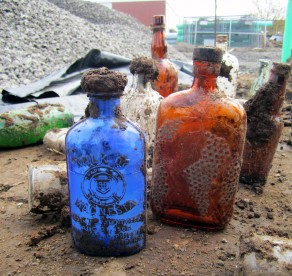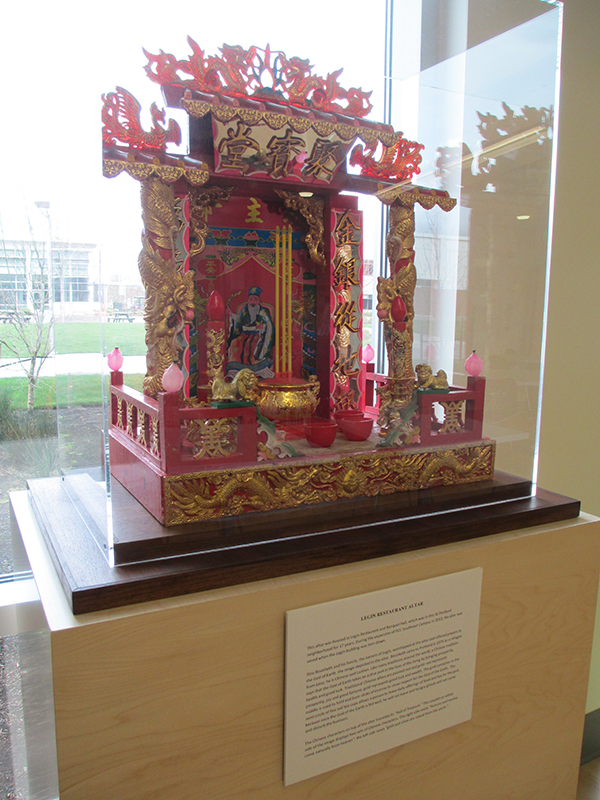This content was published: March 3, 2015. Phone numbers, email addresses, and other information may have changed.
Display of campus artifacts celebrate Southeast Portland’s rich history
Photos and story by Katherine Miller
March 3, 2015
By Katherine Miller
Portland – and Portland Community College – is rapidly growing and changing. Nowhere is that more evident than at Southeast Campus, which last year transitioned from a center to a full-fledged campus thanks to $49 million in bond-funded improvements.
The most visible improvements are the addition of two newly constructed buildings and the renovations and remodeling to Mt. Tabor Hall and the 1911 German American Society Building. But amid all the change, the past has not been forgotten.
Three new exhibits on campus celebrate the rich history of Southeast Portland, some of which took place on the very land now occupied by the new construction or improvements. Two of the exhibits are already on permanent display in new Library, where the third will join them soon.
On view in several study rooms are seven black and white photographs purchased by PCC from the Oregon Historical Society. The photos depict street scenes, undeveloped land and events from the surrounding neighborhood from 1860 through 1966. Together they show the area’s diversity and the dramatic changes that took place over the course of just one century.
One photo, from 1860, shows the humble clapboard Mt. Tabor Post Office, with a horse-drawn wagon parked out front on the dirt street. From 1911 there is the Montavilla Fourth of July parade, complete with motor cars festooned with bunting, a marching band, and everyone dressed in hats and their holiday best.
From 1953 there is a photo that could almost have been taken today on Southeast Campus, showing a “diversity panel” of five students of different ethnic backgrounds. The most recent photo, from 1966, is of a large sign at the future site of Eastgate Cinema: “To be constructed soon! Largest screen on the West Coast! All the latest theatre innovations!: cushion seats throughout; 70 mm projection equipment; 6 channel stereophonic sound.”
Also on display in the library is a small, ornate Chinese altar rescued from LeGin, a popular Chinese restaurant that for 17 years served as an important venue for Portland’s Chinese community, thanks in part to the banquet hall’s huge size, which years before had housed a bowling alley. The property was purchased by PCC in 2009 and later demolished to make space for bond-funded improvements.
The altar – a traditional fixture in many Chinese-owned businesses – was where LeGin’s owners made daily offerings for prosperity. After the restaurant closed in 2012, the owners declined to take the altar and Walsh Construction, which was responsible for the building’s demolition, stepped in to save it. It is now on display in a plexiglass box just inside the entrance to the Library.

These glass bottles were among the artifacts found in an old cistern that was discovered during excavation work on Southeast Campus. The artifacts are destined for a display on campus.
A third exhibit is planned for a collection of artifacts that were discovered in 2013 during excavation work for a new access road near where LeGin Restaurant once stood. The artifacts are from the 1930s and ‘40s and include jewel-colored glass bottles, horseshoes, a pick ax, cow bone and cooking pan. They were found in a hand-dug, conical-shaped cistern about 17 feet deep and 10 feet wide with a brick bottom and double-plastered walls. The cistern was originally built for water storage and later used as a refuse site.
To Christine Egan, manager of community relations at Southeast Campus, the exhibits are an invaluable way to bring the past to life.
“As I inventoried the existing artwork, cistern artifacts, LeGin altar and historical photographs, I noticed a theme of ‘storytelling’ or historical informal documentation emerge as an underlying concept. In general, these pieces provided a glimpse into the historical, cultural and geological history and transformation of Southeast Portland, Southeast Campus and PCC’s place in the community,” said Egan.
In addition to the displays of the photos, altar and cistern artifacts, Southeast Campus also recently hung the portraits of Henry and Luisa Weinhard that the college inherited when it bought the 1911 German American Society Building.
Henry Weinhard was a German immigrant who founded Portland’s Weinhard brewery in 1862. In 1911, his widow donated a 20-acre parcel on Southeast Division at 82nd Avenue to build an Altenheim, a retirement home for the German community. After the Altenheim closed, the building served as the offices for the German American Society until the property was sold to PCC in 2010.
After extensive renovations, the structure is now the Southeast Campus’ Administration Hall, where the Weinhard portraits currently hang.
Numerous Germans were among the earliest European settlers in the area. Today, the community that the Southeast Campus serves includes a growing number of Vietnamese, Chinese, Korean, Latino, Russian and Ukrainian families.
“Campus President Jessica Howard has often noted that the ‘German American Society Building represents one of the last historic immigrant structures in Southeast Portland, commemorating immigrants’ ongoing struggles and accomplishments in creating a new home/life in Portland.’ Thanks to voters’ support, PCC was able to restore this important structure as part of this area’s evolving immigrant history,” said Egan.
In addition to the historic displays, Southeast Campus has two contemporary photo exhibits. “Building Stories: Photographing PCC Construction Site” documents the campus’ transformation from a center and was the work of students in a pilot digital photography class coordinated by PCC Community Education and the PCC Bond Program. Six of the images are temporarily installed on the second floor of the Student Commons.
The second exhibit, “Lents-Grown Story Yard,” features photos of local business owners and farmers market vendors taken by Portland photographer Dawn DeAno. PCC’s Small Business Development Program purchased a reprint of these 15 images to display in their new Small Business Development Center at Southeast Campus. The “Lents-Grown” exhibit is also currently on display in the Southeast Campus Gallery in partnership with ROSE Community Development; on March 16 the exhibit heads to Portland City Hall for a temporary show.
PCC’s 2008 voter-approved $374 million bond program is increasing opportunities for residents to access quality, affordable higher education close to where they live and work. Additional classrooms, updated equipment and technology, and advanced workforce training programs are helping to pave the way for future employment options. For more information, visit the bond website.

